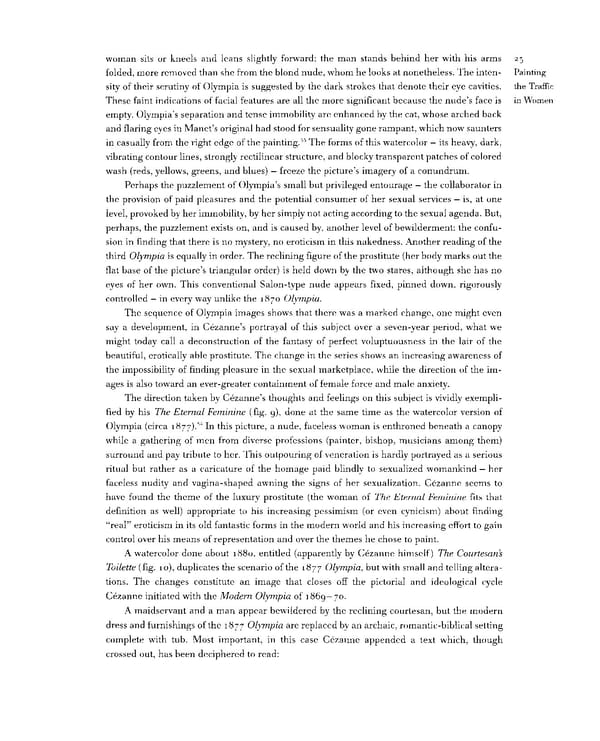woman sits or kneels and leans slightly forward; the man stands behind her with his arms 23 folded, more removed than she from the blond nude, whom he looks at nonetheless. The inten- Painting sity of their scrutiny of Olympia is suggested by the dark strokes that denote their eye cavities. the Traffic These faint indications of facial features are all the more significant because the nude's face is in Women empty. Olympia's separation and tense immobility are enhanced by the cat, whose arched back and flaring eyes in Manet's original had stood for sensuality gone rampant, which now saunters 53 in casually from the right edge of the painting. The forms of this watercolor — its heavy, dark, vibrating contour lines, strongly rectilinear structure, and blocky transparent patches of colored wash (reds, yellows, greens, and blues) — freeze the picture's imagery of a conundrum. Perhaps the puzzlement of Olympia's small but privileged entourage — the collaborator in the provision of paid pleasures and the potential consumer of her sexual services — is, at one level, provoked by her immobility, by her simply not acting according to the sexual agenda. But, perhaps, the puzzlement exists on, and is caused by, another level of bewilderment: the confu- sion in finding that there is no mystery, no eroticism in this nakedness. Another reading of the third Olympia is equally in order. The reclining figure of the prostitute (her body marks out the flat base of the picture's triangular order) is held down by the two stares, although she has no eyes of her own. This conventional Salon-type nude appears fixed, pinned down, rigorously controlled — in every way unlike the 1870 Olympia. The sequence of Olympia images shows that there was a marked change, one might even say a development, in Cezanne's portrayal of this subject over a seven-year period, what we might today call a deconstruction of the fantasy of perfect voluptuousness in the lair of the beautiful, erotically able prostitute. The change in the series shows an increasing awareness of the impossibility of finding pleasure in the sexual marketplace, while the direction of the im- ages is also toward an ever-greater containment of female force and male anxiety. The direction taken by Cezanne's thoughts and feelings on this subject is vividly exempli- fied by his The Eternal Feminine (fig. 9), done at the same time as the watercolor version of 54 Olympia (circa iS//). In this picture, a nude, faceless woman is enthroned beneath a canopy while a gathering of men from diverse professions (painter, bishop, musicians among them) surround and pay tribute to her. This outpouring of veneration is hardly portrayed as a serious ritual but rather as a caricature of the homage paid blindly to sexualized womankind — her faceless nudity and vagina-shaped awning the signs of her sexualization. Cezanne seems to have found the theme of the luxury prostitute (the woman of The Eternal Feminine fits that definition as well) appropriate to his increasing pessimism (or even cynicism) about finding "real" eroticism in its old fantastic forms in the modern world and his increasing effort to gain control over his means of representation and over the themes he chose to paint. A watercolor done about 1880, entitled (apparently by Cezanne himself) The Courtesans Toilette (fig. 10), duplicates the scenario of the 1877 Olympia, but with small and telling altera- tions. The changes constitute an image that closes off the pictorial and ideological cycle Cezanne initiated with the Modern Olympia of 1869—70. A maidservant and a man appear bewildered by the reclining courtesan, but the modern dress and furnishings of the 1877 Olympia are replaced by an archaic, romantic-biblical setting complete with tub. Most important, in this case Cezanne appended a text which, though crossed out, has been deciphered to read:
 Prostitution & Impressionists Page 43 Page 45
Prostitution & Impressionists Page 43 Page 45